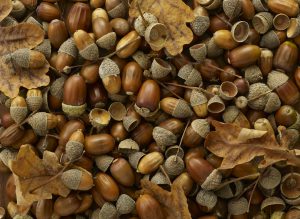
Walking through my neighborhood the other day, I noticed the live oaks along the path seemed overloaded with acorns. It got me thinking about the time several years ago when our back patio was so overwhelmed with acorns that you could nearly slide across it on the nuts. Every square inch was covered, and I would shuffle my feet just to get footing on the wooden deck. While it doesn’t seem like the local oak trees are producing at quite that rate this year, there are indications around the country that “mast years” may be in the works in some places.
The term “mast year” comes from the botanical term, mast, for tree fruit—seeds, nuts, acorns, etc. Nuts and acorns are considered “hard mast,” while berries and apples are “soft mast.” A mast year is when trees (particularly red and white oak trees in our area) produce an overabundance of fruit. High production of seeds may come from several factors. One explanation is that it can be a response to unusual weather, like rainfall or high temperatures. Locally, the very heavy rains this past spring and summer have likely contributed to the bumper crop of acorns.

Mast years are periodic but not on a regular cycle, and may also be triggered in response to a symbiotic relationship to the wildlife that pollinate and feed on the trees. Local wildlife that feed on acorns include turkeys, deer, black bears, and wild hogs.
One thing is for certain—if there are more acorns, there will be more squirrels running around this winter and even more babies this spring. So, keep an eye on your bird feeders and use caution when driving along tree-lined streets!
 1
1
